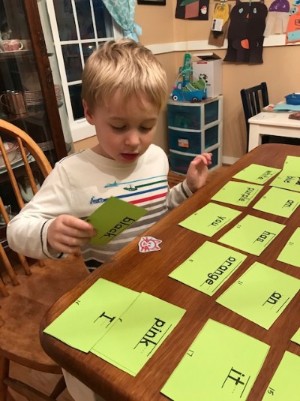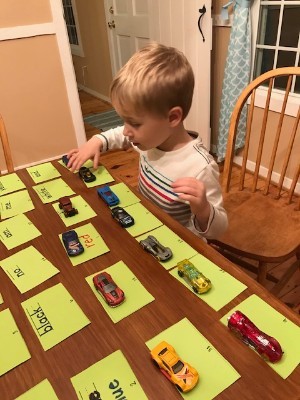9 Fun Sight Word Games for New Readers
Tick, tick, tick, I can still hear the sound of the kitchen timer counting down the minutes while I memorized my first grade sight words. At back-to-school night, my teacher informed our parents that all first graders would be responsible for memorizing their sight words, those high frequency words that do not always follow the rules of phonics. My dutiful and caring mother made flashcards, set the kitchen timer for 15 minutes, and drilled me on my sight words every night after dinner.

I remember dreading these 15 minutes more than having my yearly finger prick at the pediatrician’s office. As my mom flipped through the cards and I struggled with remembering the difference between where and were and was and saw, I longed to be doing anything else. By the end of first grade, I could fly through the pack of sight words and could even tell the different between they’re, there, and their. The boring drills worked. At the same time, they made reading a dreaded chore.
A Fresh Approach to Learning Sight Words
My son is now the student tasked with memorizing his sight words. As a mother and teacher, I am now the dutiful parent who holds the sight word flashcards. I still cringe at the thought of sitting in the kitchen every night after dinner, drilling the sight words, and listening to the timer tick down the minutes. Instead, my son and I have been playing some simple sight word games that have the same objective as the endless drills.
Just like Kix Cereal, these games are all “kid tested and parent approved.” That means my son finds them entertaining and they require very little preparation on my part. These games can be modified to suit your child. Instead of sight words, consider playing some of these games to master letter recognition with your preschooler, state capitols with your fifth grader, or even the Periodic Table of Elements symbols with your high school junior.
9 Engaging Sight Word Games
Flash Card Hide and Seek

Materials: flashcards, three or four small pictures that fit underneath the flashcards
How to Play: Place all of the flash cards face up on a flat playing surface. Have your child cover his eyes or leave the room. Hide the small pictures under the flashcards. Your child should then try to find the pictures by reading each word and then looking under the card. The game ends once your child finds all of the pictures. That’s it! My son was so entertained by this game one afternoon that he practiced his sight words for over 30 minutes!
Memory
Materials: two sets of flashcards
How to Play: This is a classic that kids still love to play. Spread the flashcards out on a table or flat playing surface. Players take turns flipping over two cards to find a match. Once a player finds a match, he or she may keep the cards. In our house, if a player gets a match, he or she may take another turn. Another house rule, if a player cannot read the words on the cards, the cards go back into play.
War
Materials: flashcards with numbers written underneath the words. Tip: Use numbers that your child recognizes and understands the value. This will vary for each child.
How to Play: This game plays like traditional War with one sight word twist. Divide the cards into two equal stacks. At the same time, players take a card from the top of their stacks and place the cards across from each other. In this version, players must read their sight words out loud. If a player can read his or her word and has the higher number, he or she gets both cards. Play continues until one player has all of the cards or until the parent says, “This game takes forever, you win!”
Flashlight Game
Materials: flashcards, tape, flashlight
How to Play: This one works well after dark. Tape your child’s flashcards to a wall or ceiling. Turn the lights out. Have your child shine a flashlight on each word. She should read each word she sees. My son also likes this game when we line the flashcards up on the staircase. I turn the lights out and he shines his flashlight on each step as he moves from the first floor to the second. Again, this is a super simple game, but one that kids enjoy.
Pancake Flip
Materials: cardboard circles, marker, spatula
How to Play: Cut small circles out of cardboard. Amazon boxes work great for this! Write a sight word on each circle. Place the circles face down on a table or other playing surface. Challenge your child to use the spatula to flip over the circles or “pancakes.” Each time your child flips over a pancake, he or she must read the sight word. It sounds ridiculous, but kids love flipping things over! This is also a great activity for building both fine and gross motor skills.
Tic-Tac-Toe
Materials: paper, writing utensil, small markers (counters, game pieces, mini erasers, coins, buttons, etc.)
How to Play: In this version of Tic-Tac-Toe, draw a Tic-Tac-Toe board on a sheet of paper. Write a different sight word in each square. Using two different types of small markers, try to get three in a row. In order to play a square, the player must read the sight word out loud. Your child may also cross out any word that he reads. I prefer to use mini erasers when we play because they are cute and it saves paper. Kids want to play this one over and over!
Stinky Cheese
Materials: yellow and orange construction paper cut into small triangles, brown paper bag, writing utensil, timer
How to Play: This game does require a bit of preparation. Cut the yellow and orange construction paper into small triangles. The triangles do not have to be perfect or the same size. Write a sight word on each of the yellow triangles. Leave the orange triangles blank. The yellow triangles are the cheese and the orange ones are the stinky cheese. Place all of the triangles in the bag.
Set the timer for five minutes. Play begins as one player pulls a triangle out of the bag without looking. If the triangle is yellow, the player must read the sight word on the triangle. If she reads the word correctly, she gets to keep the cheese. Play continues as players take turns pulling triangles out of the bag. If a player gets an orange triangle (stinky cheese) she must put all of her cheese back in the bag. The game ends when all of the yellow cheese is claimed or when the timer goes off. The player at the end of the game with the most cheese is the winner!
Read Together
Materials: multiple copies of sight word lists
How to Play: This one is more of a confidence builder than a game. For Read Together, simply sit next to your child and together read through his sight words. The child and parent should read each word at the same time, almost in a chant. Each time you play, keep the words in the same order. Encourage other family members to read along. This is a great activity for kids who become frustrated quickly with sight word memorization. They do not feel alone as they practice reading their words.
Hot Wheels Game

Materials: sight word flashcards, toy vehicles
How to Play: My kindergartener created this game and it has quickly become his favorite. He places all of his flashcards face up on the kitchen table. Then, he places a toy vehicle on top of each word. As he drives off the cars, he read the sight words underneath. If he cannot read the word, we review it and then he moves the card to the “parking lot.” He places more vehicles on top of the cards in the parking lot. Play continues until he reads all of the words and all of the cars are off the lot.
Books For Beginning Readers
Now that your child has practiced reading sight words in isolation, try finding them in some books for beginning readers or in some books specifically geared towards first and second graders.
Thanks for reading.
Please Share, Comment, Like the post And Follow, Subscribe CTS Store.
from Source




Post a Comment